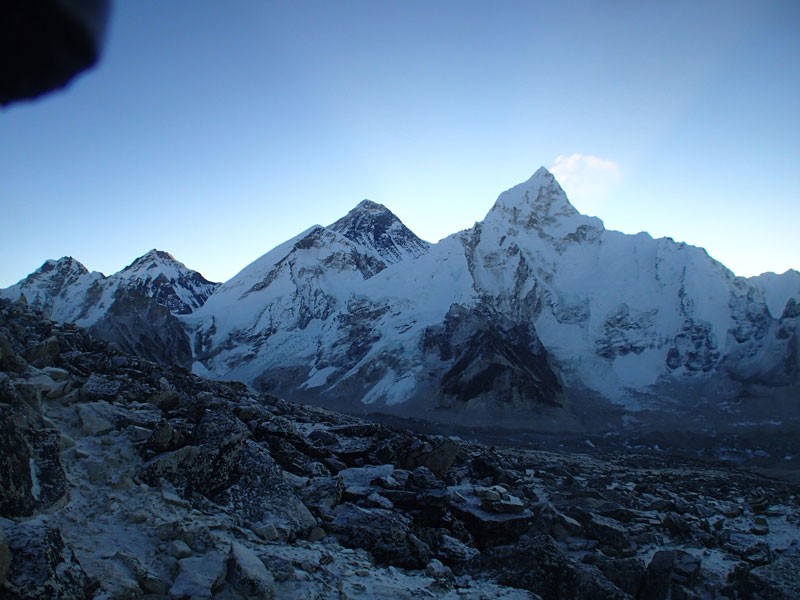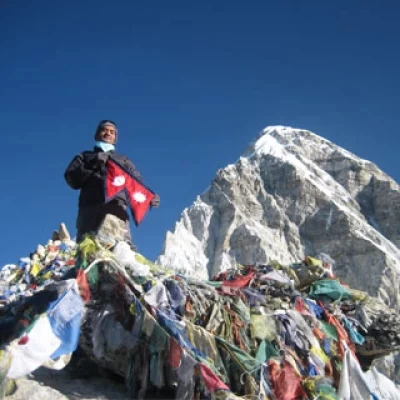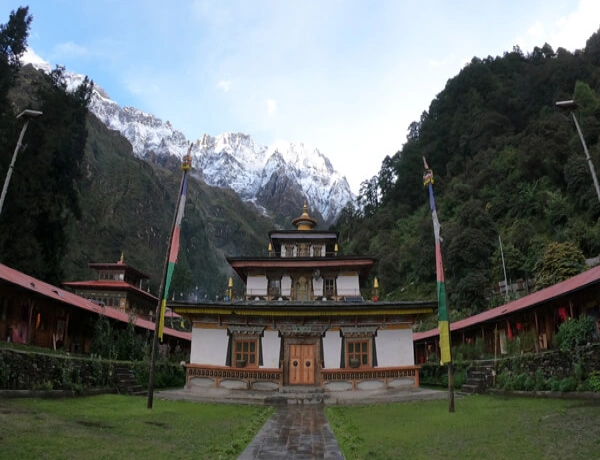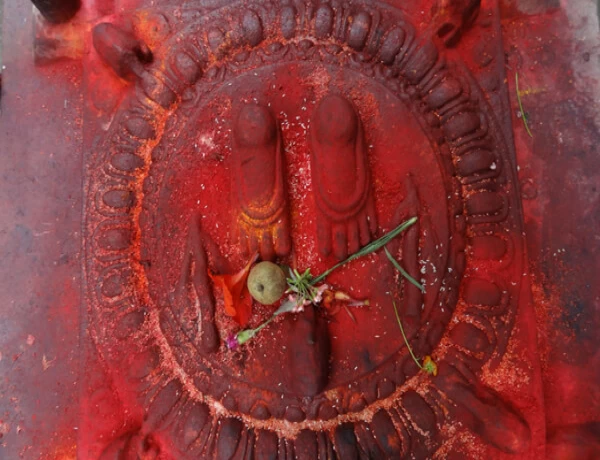Literally, “Kalapatthar” means “Black Rock” in the Nepali tongue; it is a composition of two different words, Kala and Patthar. The most popular landmark, Kalapatthar, is situated on the southern ridge of Mt. Pumori in the Khumbu Himalayan Range and just above the Gorakshep. Sometimes people pronounce it as Kalapattar, but to be clear, it is Kalapatthar. This is the most famous viewpoint in the Khumbu region, from where Mount Everest is the closest distance.
Kalapatthar lies on the north of Gorakshep, gaining an elevation of 5,555 meters from sea level. Many people stay overnight in Gorakshep before and after the Base Camp visit and climb this peak from here in the morning. This is the most appropriate place in the area to have a closer panoramic view of Everest and other surrounding peaks, Khumbu Glacier, Icefall, and other sceneries. The trail from Gorakshep to the peak is about 1.5 km long and the height difference is about 400 meters. It takes about 2 to 3 hours of hard work to ascend to reach the summit. About 100 meters above Gorakshep, a platform-like topography develops along the trail.
Here an astonishing view around the visitor, including the view of Everest, makes it worth the hard labor that was put into reaching this wonderful place on earth. Up to the platform, the builders on the trail are mostly composed of granites possibly derived from the upper reaches of the Khumbu Glacier as moraine boulders.

As the trail goes higher, the view around becomes more and more impressive. The top of the Kalapatthar provides the ultimate view of the area, including the Everest summit (8,848.86 m) and many mountains.
Kalapatthar Highlights
Elevation (feet): 18,373 F
Elevation (meters): 5,600 m
Continent: Asia
Country: Nepal
Range/Region: Khumbu Himalaya Range in Central Region
Latitude: 27.995517
Longitude: 86.829262
Difficulty: Moderate to Strenuous
Walking Time: 2 Hours
Hiking From: Gorakshep (The last Tea House for Everest Base Camp Trek)
Best season: September, October, November, March, April, and May.
Nearest Airport: Lukla
Mount Everest Base Camp Trek: Essential Tips and Information for Your Successful Trip on the Base of Top of the World “Mt. Everest 8,848.86m”
Here is a list of some tips that help to make your trip successful. Kindly go through it.
- Experience the Ultimate Everest Base Camp Helicopter Tour:A Comprehensive Guide
- Daily Bus and Jeep Service from Kathmandu to Lukla: Private and Shared Options Available
- 7 Money-Saving Tips to EnhanceYour Everest Base Camp Trek Experience
- Experience the Adventure of a Lifetime: The Ultimate Guide to Everest Base Camp Trek in 2023-2024
- 14-Day Everest Base Camp Trek Itinerary: A Step-by-Step Guide for a Memorable Journey
- Unlocking the Secrets of Everest Base Camp Trek: Top 7 Insider Tips You Need to Know
- 30 Mind-Blowing Facts About Mount Everest: Discovering the World's Tallest Mountain
- 15 Essential Tipsfor a Safe and Enjoyable Trek to Mount Everest Base Camp
- Lukla Airport: Your Gateway to the Top of the World Adventure
- Where is Mount Everest Located? Exploring the Geographic Wonder of the World
- The Best Time to Trek to Everest Base Camp: A Guide to Choosing the Perfect Season
- Everest Base Camp Elevation: What You Need to Know Before You Go
- How Much Does an Everest Base Camp Trek Cost? A Breakdown of Expenses and Savings Tips
- Getting to Everest Base Camp: A Comprehensive Guide to Transportation and Routes
- Your Ultimate Everest Base Camp Trek Packing List: Essentials and Recommendations
- Understanding Flights from Kathmandu to Lukla: Why Departure from Ramechhap is Recommended
What is the Best Time to Visit Kalapatthar?
In the Western country, there are four seasons in a year: winter, spring, summer, and autumn. But in the context of Nepal, we have six different seasons with an additional two seasons on it: pre-winter and rainy season. Spring (March, April, May) and Autumn (September, October, November) are great times to hike in the Himalayas, including Kalapatthar or any other trekking region. The weather is pleasant, neither hot nor cold during this time. Many festivals fall during the Autumn season, so you have a chance to see Nepalese culture and tradition and bestow amazing snow-capped Mountain Views with blue sky. Spring is the best time for trekking, especially for the mountaineering expedition. The entire Expedition group for Mt. Everest and other areas chose the spring to climb due to a suitable time. The jungles of the high Himalayas are full of Rhododendron and magnolia flowers in the spring.
Chart of the Six Different Seasons in Nepal
| S.N. | Name of Season in Nepali | Name of Season in English | Nepali Month | English Month |
| 1. | Basanta Ritu (बसन्त) | Spring | Chaitra & Baisakh | Mar, Apr, May |
| 2. | Grishma Ritu (ग्रिष्म) | Summer | Jestha & Ashad | May, Jun, July |
| 3. | Barsha Ritu, (बर्षा) | Rainy | Shrawan & Bhadra | July, Aug, Sept |
| 4. | Sharad Ritu (शरद) | Autumn | Ashoj & Kartik | Sept, Oct, Nov |
| 5. | Hemanta Ritu, (हेमन्त) | Pre-winter | Mangshir & Poush | Nov, Dec, Jan |
| 6. | Shishir Ritu, (शिशिर) | Winter | Magh & Falgun | Jan, Feb, Mar |
Everest Basecamp Trek Video
What is the best time of the day to visit Kala Patthar?
As you are coming a long way from your home to see Mt. Everest once in your lifetime, it would be best to visit Kalapatthar any time in good weather. Most of the trekkers visit the Kalapattar in the morning, but while the sun rises, the light makes the camera light while taking a picture. So, sunset is the best time for a magical view of Mt. Everest with different colors. You need to be well prepared with warm clothes for the cold and walk in the dark.
Accommodation Facilities nearby Kalapatthar: Gorakshep (5,140 m) is the last tea house for the Everest Base Camp Trek and Kala Patthar Trek. There are more than four tea houses here, and more than 400 people can be accommodated in one night. Everest day after 4:00 PM, they put on fire in the chimney to keep the dining hall warm. And they have a huge menu for vegetarian meals.

How far is Kalapatthar from Lukla?
It takes 7 to 8 Days to walk from Lukla to Kalapatthar, including the 2 acclimatization days at Namche Bazaar and Dingboche. It is very complicated to measure the exact distance with any gadget due to geographically dissimilar structures. Generally, Lukla to Everest Base Camp is about 65 Km separately, while a complete EBC trek would be 130 km. normally, to calculate the distance, it is better to remember that ‘the human walking speed is 5 km per hour”. Gorakshep is the only landmark near Kalapattar. To get to the top of the Kalapatthar from Gorakshep, you need to ascend 1.5 kilometers, taking 2 to 3 hours of walking. You can imagine how it is easy to get on top.
Main Attraction of Kalapatthar
The entire trail of Kalaptthar itself is amazing to experience walking in the Sagarmatha National Park World Heritage Site. Valuable Vegetation, endangered wildlife such as snow leopards and snowcapped mountain scenery, Sherpa Unique culture, sacred Buddhist sites, and the Monastery are fascinating to the visitors. Especially Khumbu Icefall, Khumbu Glacier, Glacier Marine, Glacier Lake, astonishing views of Mt. Everest, and many other mountain scenes are key attractions of the Kalapathar. From the Kalapattar, you can see Mt. Everest Base Camp (5,360 m) just below the Khumbu glacier and Khumbu Icefall. Mt. Pumari (7,145 m), Lingtren (6,695 m), Khumbutse (6,623 m), Changtse (7,550 m), Nuptse (7879 m), and especially Mt. Everest (8,848 m) itself surround the amazing viewpoint of Kalapatthar. The German surveillance firm Mobotix set up the world's highest webcam at Kalapatthar in September 2011 to study Global warming.
Most popular trek in the Everest Region:
- Everest Base Camp Trek: -12 Days
- Everest Base Camp Trek and Fly Back Helicopter: -9 Days
- Everest 3 Passes Trek -21 Days
- Everest Base Camp Trek -8 Days
- Gokyo Chola Pass Trek (19 Days)
What is the elevation of Kala Patthar?
As Kala Patthar is the ridge of Mt. Pumori, sometimes people are confused about the summit of Kala Patthar. But to easily recognize it, you can see a colorful Buddhist prayer flag on the top of the Kala Patthar. So, different people have measured their height differently. Most books and maps mention the height of Kala Patthar as 5,545–5,550 m (18,192–18,209 ft). But Portland State University Assistant Professor Dr. Luis A. Ruedas measured the elevation of Kalapatthar as 5,600 meters/18,373 feet with a Garmin eMap GPS unit on 6 December 2006. The next researcher, using a GPS with WAAS, proved 2006 data of Dr. Luis A at the summit at 27°59.751'N, 86°49.705'E (datum: WGS84) with an elevation of 5,644.5 m (18,519 ft).

How do I get to Kalapatthar?
There are main trekking routes for the Kalapatthar: first, drive from Kathmandu to Lukla via Salleri and Phaplu and Andheri Khola trek to Lukla, and the second option is flying from Kathmandu to Lukla by regular flight, it is a 25- to 30-minute scenic flight. Then walk along the Everest Base Camp Trekking trail to Gorakshep and climb for about two hours on the top of the Kalapatthar. If you don’t have such a long holiday to see Mt. Everest from Kalapatthar, then you can fly 3 to 4 hours by Helicopter round trip from Kathmandu. Comparatively, the helicopter flight seems expensive but we can’t compare the value of Kalapatthar with the Helicopter cost.
Here is the Kalapatthar Trek Itinerary:
Day 01: Fly from Kathmandu to Lukla (2,800 m) for 30 minutes; trek to Phakding (2,640 m) 9 km -3 to 4 hours
Day 02: Phakding to Namche Bazaar (3,430 m) 12 km -5 to 6 hours
Day 03: Day of acclimatization & Explore Namche Bazaar and visit Khumjung Village (3,790m), Everest View Hotel (3,800m)
Day 04: Namche Bazaar to Tyangboche (3,867 m) 12 km -5 to 6 hours
Day 05: Tyangboche to Dingboche (4,300 m) 12 km -5 to 6 hours
Day 06: Acclimatization day at Dingboche
Day 07: Dingboche to Lobuche (4,930 m) 12 km -5 to 6 hours
Day 08: Lobuche to Gorakshep (5,140 m) 8 km, 3 hours & Everest Base Camp (5,364 m) 8 km -2 to 3 hours
Day 09: Gorakshep to Kalapatthar (5,555 m) 1.5 km -2 hours & Stroll back to Pangbuche (3,980 m) 12 km-5 to 6 hours
Day 10: Pangbuche to Manjo (3430 m) 10 km, 4 to 5 hours
Day 11: Manjo to Lukla (2,800 m) 8 km, 3 to 4 hours
Day 12: Fly back to Kathmandu and enjoy the rest of the day. Then final Departure to your Destination.
Note: The Kalapthar Trek Itinerary can be customized according to trekkers' requirements and longer combined with the Everest Cho La Pass or Everest Three Passes Trek.
If you require any further information, please feel free to contact Nepal Mother House. We are here for your assistance.




